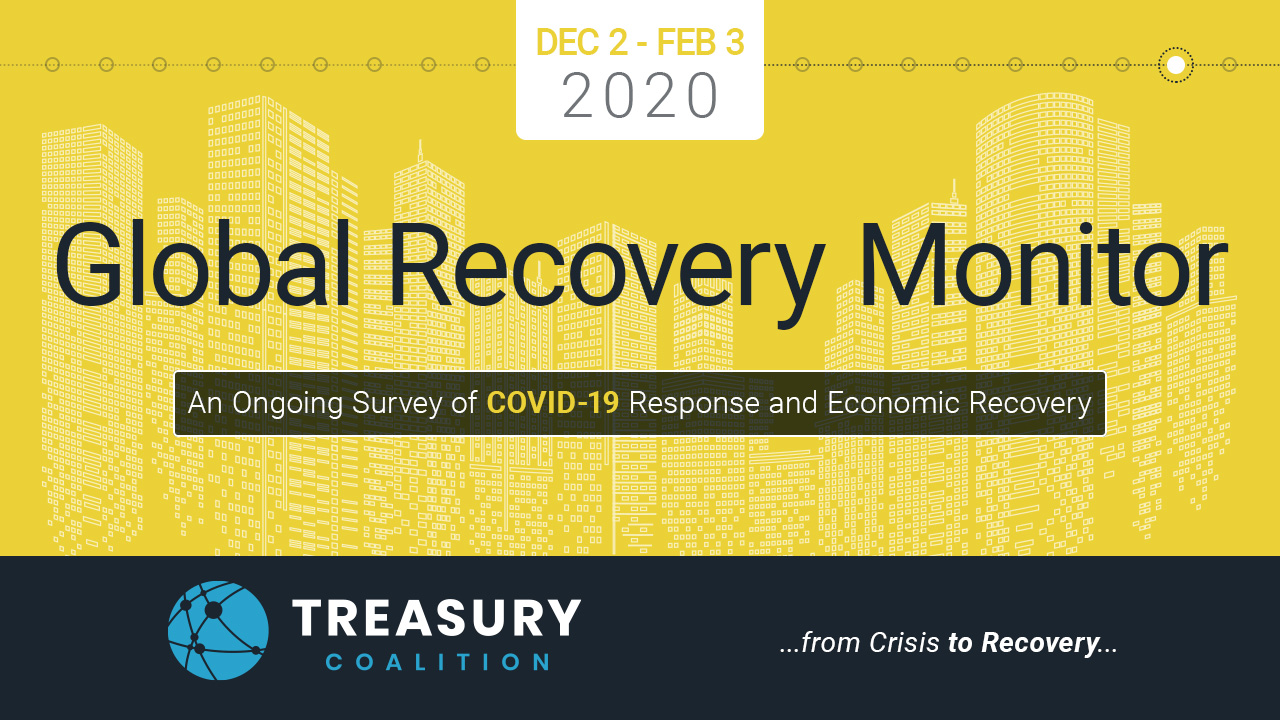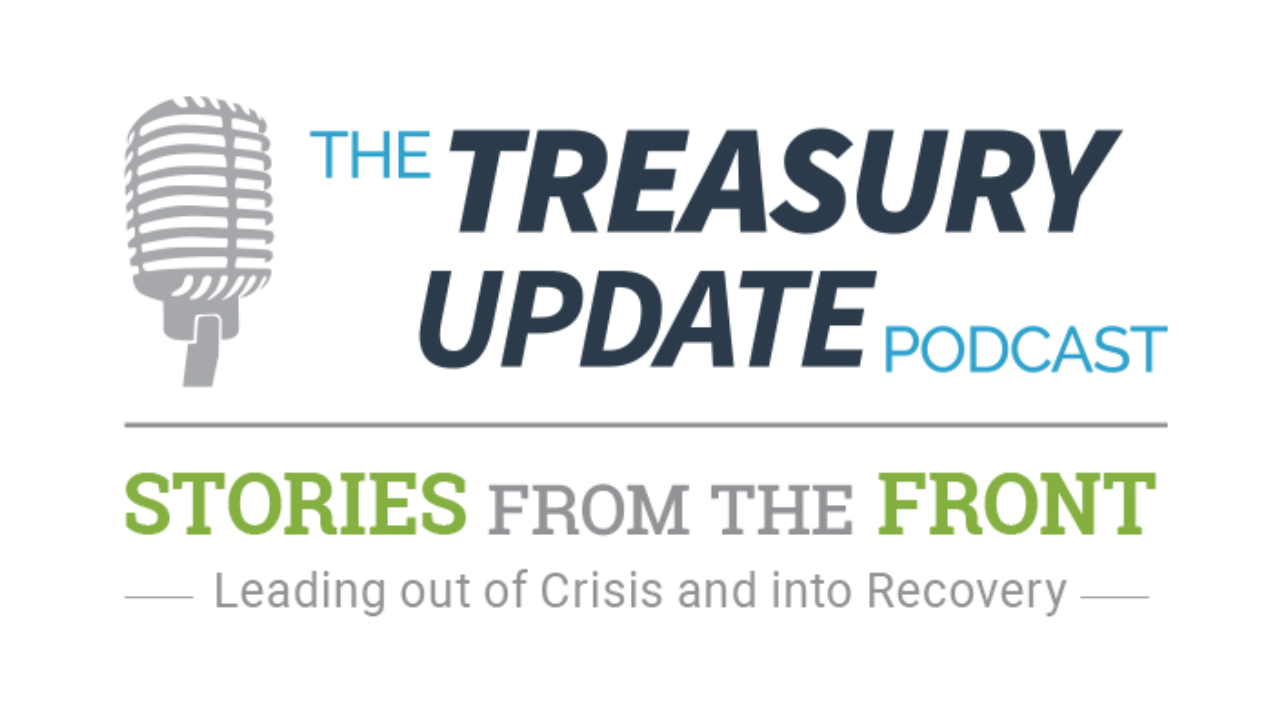
Episode 128
2020 Treasury in Review
On this episode of the Treasury Update Podcast, Special Host Meredith Zonsius interviews Craig Jeffery, Managing Partner of Strategic Treasurer, on the 2020 year in review. As the new year approaches, they take a look back on treasury topics and trends amid the COVID-19 pandemic. They discuss the implications of activities to combat the virus that wreaked havoc earlier in the year for most areas of the economy and cover some elements of recovery while looking ahead to 2021. Listen in to the discussion to find out more.
Host:
Meredith Zonsius, Strategic Treasurer


Speaker:
Craig Jeffery, Strategic Treasurer


Subscribe to the Treasury Update Podcast on your favorite app!
Episode Transcription - Episode 128 - 2020 Treasury In Review
Speaker 1:
Welcome to the Treasury Update Podcast presented by Strategic Treasurer, your source for interesting treasury news, analysis, and insights in your car, at the gym, or wherever you decide to tune in. On this episode of the Treasury Update Podcast, special host, Meredith Zonsius, interviews Craig Jeffrey, managing partner of Strategic Treasure on the 2020 year in review. As the New Year approaches, they take a look back on treasury topics and trends amid the COVID-19 pandemic. They discuss the implications of activities to combat the virus that wreaked havoc earlier in the year for most areas of the economy and also cover some elements of recovery while looking ahead to 2021. Listen in to the discussion to find out more.
Meredith Zonsius:
Welcome to the show. Can you please share some of your thoughts on the 2020 economy from a treasurer’s perspective?
Craig Jeffery:
Sure, Meredith. Thanks. 2020 started off very quickly, very strongly economically. And then we hit this massive trough starting in mid-March in North America as the COVID virus continued to move from China to other areas in Asia-Pac region, across to Europe, and then to North America. That had a major impact in a lot of areas. As we looked at, unemployment, GDP, equity markets. What we saw in this trench, this trough that started mid-March and the deepest part of the situation happening in April, we saw recovery occur in the summer, and it was a very dramatic snapback, not a full snapback, but we saw a good recovery in the summer, ongoing, solid progress in the fall. And as we’re at the border of the fall winter area, where we’re still seeing recovery, it’s slowed a bit, but we’re still moving in a positive direction.
Craig Jeffery:
From the employment standpoint, I mentioned the massive drop. When you just look back at the numbers, we saw in February, unemployment was really low at 3.5% in February. By the time we hit April, April’s numbers were at 14.7% unemployment. In that month, we lost 20.8 million jobs during the month of April. That is the largest decline in jobs, I think the economists tell us what occurred. So at 14.7% in April. In November, that had continued to recede. Unemployment sat at 6.7% at the end of November. So we’ve recovered 8% of the unemployment numbers. So a good snapback, but still 6.7% is quite a bit more than 3.5% where we were in February. So there’s a lot of dislocation. There’s a lot of people that are hurting in those areas and particularly some industries. From a GDP standpoint, in February, we were running at around $22 trillion a year.
Craig Jeffery:
We hit a trough in April down to about an 18.6 trillion annualized rate, but that’s rebounded almost 3 trillion, just about one sixth. You know, we’ve come up about one sixth of the economy in that timeframe. So we’re sitting at a little over 21 and a half trillion on a GDP basis. And the equity markets, if you look at the Dow, we’re sitting right now, just above 30,000, which is a peak. So very disruptive year, big drop, very rapid and deep drop, and a recovery that started maybe a little bit more than a month after it started.
Meredith Zonsius:
Economically, it has been a year of great dislocation and volatility. Treasury groups have responded to the situation well, as you have said before. Talk me through some of their responses to the crisis.
Craig Jeffery:
Yeah. So the Treasury Coalition is a group we lead and put together with a number of other treasury organizations from technology firms to associations, tech providers. We asked a lot of questions on surveys throughout the pandemic and the recovery. One area that is not a surprise has to do with business travel. That’s obviously way down. We don’t really expect it to reach 50% of its prior levels, and that keeps getting pushed out. So it’s past the second half. It’s third-quarter of 2021 before we expect it to recover to half. So that’s a significant issue. So for treasury, virtual events in particular are a challenge, both for the companies that want to attend to train their teams and make connections, but also for the banks and the vendors. So virtual events, people are working hard to use those to fill up the physical event gap.
Craig Jeffery:
And most people are thinking that there’s going to be at least a half a year without much in the way of physical events and perhaps all of 2021. So that’s a negative element there. The concerns about jobs and is your job at risk, even for treasury, there’s been heightened concerns about their positions. It was extraordinarily high early on in the Treasury Coalition of the monitor that we were running. It’s been very elevated, but it’s continued to abate, and there’s still a lot of room for it to pull back. It’s abated from its peak. It’s pulled back, and I’d encourage you to go to treasurycoalition.com to just download any of those reports to see how that’s changed over time.
Craig Jeffery:
But finally, the other response to the crisis that we’ve seen is this work from home. How does that work? Couple things. So work from home had an impact on fraud, on business processes, because we’re no longer in the office. And this idea that we’re going to return always seemed imminent. And then it got farther out, and now it continues to stay a distance, six months or nine months. And the perspective that the work from home environment may change permanently continues to get press. And there’s less expectations that people will manage it all from the office anytime soon.
Meredith Zonsius:
Work from home and security, you have commented on this before. What has happened?
Craig Jeffery:
Yeah. So the criminals haven’t stopped. There was a slight decrease in terms of what they were doing with hospital organizations in health care. So there was some honor among thieves that lasted not too, too long, but there was a bit of a pullback there, but they were also adaptive. They kept working. They took advantage of the situation and leveraged things like now people are working from home. So their messages, whether it was via email or phone calls or communication, when they’re trying to steal funds or access data, they would share partial truths. So this idea of, “Hey, we need you to send payments here because our main office is closed,” and some of the best lies have truth intermingled in them. And so, yeah. “Oh, they are close with our main office. So maybe we can redirect payments.” So there was a significant rise in fraud and attacks and the methods of creating those attacks and the sophistication.
Craig Jeffery:
And so we measured some of that throughout the pandemic. We saw a net increase of fraud, 36% of companies that indicated it had risen were somewhere around 36% earlier on. Later on, it had reached 46%. And now it sits at over 50% of companies have noticed elevated number of attacks, type of attacks in the era of COVID. You also mentioned, “What has happened?” So I think there was a couple of corresponding responses to that, not just by the criminals, but by the corporate practitioners and by banks. Certainly we’re seeing more firms are taking security seriously. They’re communicating it more broadly. There are certainly more companies taking and providing security training in a more diligent manner to their groups, providing it, having testing. And I want to say that’s really encouraging, but I want to make sure that there’s no question that there’s still a huge gap.
Craig Jeffery:
There’s a lot of organizations that aren’t being diligent about payment security training, for example. Despite the good progress in the past year, there’s still a significant number that aren’t doing it effectively or well or doing training on payment security. But those that find themselves in that situation in the corporate world are in the minority now. They’re not the majority. And so that’s a less defensible position. And so we continue to encourage people to take security training, particularly around payment security training, not just desktop security training, and don’t fall for phishing emails. For those who are listening, if you want to know more about that, you can feel free to email us at securitycourse@strategictreasurer.com. You can see that information in notes. We have some information about the security training for payments that I think you’ll find interesting if you don’t already have that type of training in place.
Meredith Zonsius:
Anything else to report on the work from home impact?
Craig Jeffery:
Oh yes, the work-from-home situation. The pandemic drove people home. That created challenges because everyone was in this business continuity plan, this changed environment, and what we’ve seen so far, I know we haven’t reached the end of 2020, as we were tracking the movement from paper to electronic, the digitization, moving from manual processes, paper processes, to electronic. It looks, based on where we are now that the year’s going to end up providing two to two and a half years worth of the normal rate of movement from paper to electronic or digitalization. So it’s 200 to 250% speed of moving to that. So that’s a lot of movement in one year. We’re covering two, two and a half years, and that’s exciting, I think.
Meredith Zonsius:
That is exciting. What other changes have you observed in treasury this year, whether COVID induced or not?
Craig Jeffery:
Oh, well forecasting because of the stress on financial supply chains, regular supply to physical supply chains, forecasting became a big issue, and we’ve done a few podcasts interviewing people about running more models, the happy model, the not so happy, the hyper-negative model. This is a key driver to make sure organizations have sufficient cash. They can determine what they can look at with different assumptions. So this really put a lot of pressure on those who are working only with Excel to run two, three, or four or five models. Almost impossible in some cases. So people are looking at leveraging tech to help on the forecasting. That’s a big, big issue and driving a lot of good behavior there. Second, and this might be to your question, you said, “COVID induced or not.”
Craig Jeffery:
So I’m not sure this was induced by COVID, but this idea of a faster shift to certain type of payments, but more importantly, what I’d like to mention has to do with AI, artificial intelligence and machine learning and RPA, and there’s some really good information on that. So if you look at where we were with expectations, the use of APIs and expectations for adoption over the next two years. What’s changed? It’s really fascinating. If you look at one survey, treasure perspectives in 2019, had an adoption rate of 17% with an expectation of reaching 38% in two years. That was the expectation a year ago. In this year’s survey, we’re already at 39%. So looking out two years ago, a year ago, we’ve already exceeded an expectation of two years worth of growth on the API front. Now this new expectation is that 69%, just under 70% of organizations, will be leveraging APIs.
Craig Jeffery:
So that’s pretty significant. Whether it’s driven by just the overall efficiency or it was helped by some of the challenges of COVID, that might be a little bit harder, but that’s a significant number. Now I’ll mention one other piece, too. It’s not quite as dramatic as APIs, but has to do with AI, machine learning or predictive analytics. In 2019, looking at where they were and looking out next two years, we were looking at about 7% adoption of using AI and expected to reach 25% out two years. So that would be in 2021. But as we look this year, the adoption rate had hit 15%. So 15% adoption rate. And the expectation now in two years is 47%. So that’s a pretty significant jump from a two-year expectation, 25% to now 47%. That’s hockey-stick growth expectations, but very significant, more than doubling of both of those tech services in use.
Craig Jeffery:
The other change that we saw in treasury this year is we’ve seen a significant, not hockey-stick, but a significant increase and focus on research and benchmarking data that’s out there. And we don’t know if the growth in looking at what others are doing and where they are and how this has changing over time is due more to the desire to be efficient or that there’s more time to do analysis and therefore, to consume data and see how that applies to their business. So we’ll let you know what we see from that, but we’re getting a lot more interest in research and seeing what’s happening there. So those are some of the big changes we’ve seen in 2020.
Meredith Zonsius:
What’s the outlook on 2021?
Craig Jeffery:
Yeah, what’s the outlook for 2021? I’m not an economist or a prognosticator, but just a couple of thoughts. I think one is health on the impact of vaccinations. So they’ve been just starting to roll out. So seeing how that provides broader herd immunity and safety, especially among the health care professionals and the elderly. And then as that expands, I think that’ll be very interesting to see how quickly that allows us to get back to whatever the new normal is. So we’ll want to look and see how that plays out. And I’m expecting that that’s going to have a pretty significant impact because while there was a large rise in cases, there was better ways of treating and much lower death rates. So this can curtail that even further, decrease the number of cases, provide relief to the hospitals. That will have, I think, a pretty big rebound impact on the economy. Again, I’m not an economist there.
Craig Jeffery:
The other has to do with the elections. We saw as we’re taking the surveys, one of the top areas that escalated as we reached in November, particularly for North America and the US for the elections was a top issue. So was civil unrest. And right now there’s the US Senate, as there is a potential that it will be balanced 50-50. If it’s 50-50, the split would go to the Democratic party. And if it’s Republican, it would be a split house, Democratic Senate Republican, and that would require a lot more compromise, so less dramatic shifts, if you will. So I think that will be a big factor on economics. What happens? Are changes going to be slower, more compromised, or more dramatic? We tend to see more dramatic movements when one party controls the three branches of government, and much more compromise when there’s a split.
Craig Jeffery:
I guess finally, on the outlook for 2020, seeing how fast we’ve recovered or rebounded, we haven’t recovered all the way, but there’s been a really significant rebound across a number of factors. I think that puts us in a good position. There’s certainly a lot of softness and lowered expectations, but I think we’re pretty well positioned. It feels a lot better than it did in the middle of April when everything was deepening in the trough.
Meredith Zonsius:
Well, this has certainly been an interesting year. I’m looking forward to what the New Year has in store. Thanks for your sharing your insights, Craig.
OUTRO:
You’ve reached the end of another episode of the Treasury Update Podcast. Be sure to follow the Strategic Treasurer on LinkedIn. Just search for Strategic Treasurer. This podcast is provided for informational purposes only, and statements made by Strategic Treasurer, LLC on this podcast are not intended as legal business consulting or tax advice. For more information, visit and bookmark strategictreasurer.com.
Related Resources
Take this 5-minute survey to contribute to the ongoing research of the impact of COVID-19 and other major events on the treasury and finance industry.
Stories from the Front – A Treasury Update Podcast Series
This series features interviews with treasury and finance leaders exploring: challenging situations; fresh ideas, innovative approaches, case studies and recommendations from senior treasury practitioners. These stories from the front provide a transparent look at various industries and challenging situations that provide insights and wisdom to help guide the profession into a proper mindset and approach as we continue the path of recovery.








